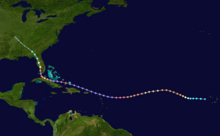 Track of Hurricane Irma | |
| Meteorological history | |
|---|---|
| Formed | August 30, 2017 |
| Extratropical | September 12 |
| Dissipated | September 13, 2017 |
| Category 5 major hurricane | |
| 1-minute sustained (SSHWS/NWS) | |
| Highest winds | 180 mph (285 km/h) |
| Lowest pressure | 914 mbar (hPa); 26.99 inHg |
| Overall effects | |
| Areas affected | Cape Verde, Leeward Islands (especially Barbuda, Saint Barthelemy, Anguilla, Saint Martin and the Virgin Islands), Greater Antilles (Cuba and Puerto Rico), Turks and Caicos Islands, The Bahamas, Eastern United States (especially Florida) |
Part of the 2017 Atlantic hurricane season | |
Hurricane Irma was an extremely powerful Cape Verde hurricane that caused extensive damage in the Caribbean and Florida. Lasting from late August to mid-September 2017, the storm was the strongest open-Atlantic tropical cyclone on record and the first Category 5 hurricane to strike the Leeward Islands. Classified as the ninth named storm, fourth hurricane, and second major hurricane of the hyperactive 2017 Atlantic hurricane season, Irma developed from a tropical wave near the Cape Verde Islands on August 30. Favorable conditions allowed the cyclone to become a hurricane on the following day and then rapidly intensify into a major hurricane by September 1 as it moved generally westward across the Atlantic. However, dry air and eyewall replacement cycles disrupted further strengthening, with fluctuations in intensity during the next few days. Irma resumed deepening upon encountering warmer sea surface temperatures, while approaching the Lesser Antilles on September 4. The system reached Category 5 intensity on the following day and peaked with winds of 180 mph (290 km/h) shortly thereafter.
Irma made its first landfall on Barbuda early on September 6 at peak intensity. The hurricane also struck Saint Martin and Virgin Gorda in the British Virgin Islands at Category 5 intensity later that day. Upon clearing the Leeward Islands, the cyclone continued west-northwestward toward the Bahamas. Around the time of landfall on Little Inagua Island early on September 8, Irma weakened to a Category 4 hurricane, after being a Category 5 hurricane for about 60 consecutive hours, the second longest contiguous time period as a Category 5 hurricane on record. Late on September 8, the storm re-intensified to Category 5 southwest of Ragged Island. Irma made landfall near Cayo Romano, Cuba, at that intensity, becoming the first Category 5 hurricane to strike the island since 1924. Although land interaction weakened Irma to a high-end Category 2 hurricane, the system re-intensified to Category 4 status as it crossed the warm waters of the Straits of Florida, before making landfall on Cudjoe Key on September 10. Irma weakened to Category 3 status prior to another landfall in Florida on Marco Island later that day. The system degraded into a remnant low over Alabama, and ultimately dissipated on September 13 over Missouri.
Irma caused widespread devastation in the Caribbean, with a total of $27.16 billion (2017 USD) in damages and 27 deaths being attributed to the hurricane accumulative of all affected areas in the Caribbean. The hurricane was the costliest to ever impact the state of Florida, with at least $50 billion in damages and 92 fatalities left behind by the storm. With damages totaling to $77.16 billion (2017 USD), Irma is the fourth-costliest tropical cyclone on record.
© MMXXIII Rich X Search. We shall prevail. All rights reserved. Rich X Search
